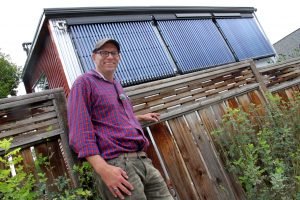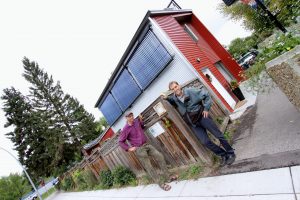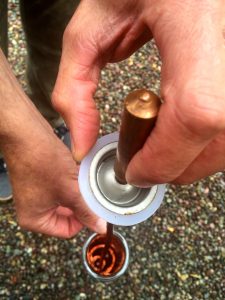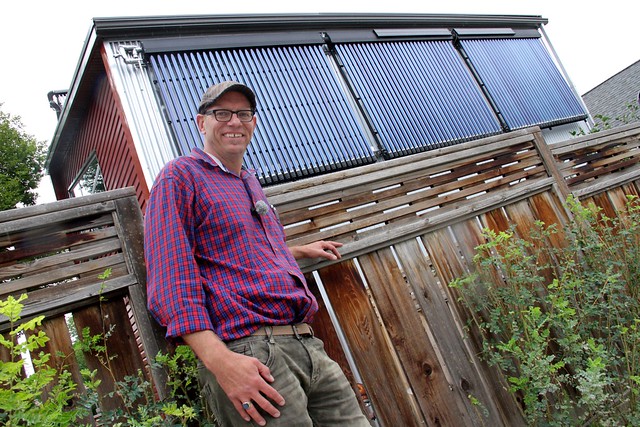By David Dodge and Dylan Thompson
“Not enough!”
That’s what Cornelius Koster told Tom Jackson of Simple Solar. The latter had presented a quote for a modest solar thermal heating system for Koster’s energy efficient garage suite.
But Koster had grander ambitions. He told Jackman to oversize the system. Use every square inch of space.

Cornelius Koster installed 5.5 kilowatts of solar PV to generate electricity and 12.5 kilowatts of solar thermal collectors to supply more than enough hot water and heat for the suite. Excess energy is exported to the main house making the garage suite net-positive in terms of energy. Photo David Dodge.
“He wanted as much solar power as he could get on that building so we’ve maximized the density,” says Jackman. Maximizing density in this case meant installing six solar thermal collectors to produce heat and hot water and five kilowatts of solar PV to produce electricity.
“So, just doing solar photovoltaic, it would’ve been a much smaller level of energy production,” says Jackman.
Solar thermal advocates are fond of reminding us that homes, especially those in Canada use about 70 per cent of their energy for heating. As solar photovoltaic prices continue to plummet, some net-zero home builders have started pairing solar PV with air-source heat pumps for space heating and electric resistance water heaters to produce hot water.
They say it’s more economical.
Solar thermal made simple
But Jackman says don’t count solar thermal out just yet. Simple Solar has patented a stripped-down approach. What his company does is place a simple, solar-powered DC pump between the solar collectors and the water tank. The pump for the solar collectors is powered by a small solar PV module built in to the solar thermal collector – when the sun shines the collectors heat the glycol, the solar PV runs the pump and glycol is pushed through heat exchangers in the water tank.
“The brighter the sun shines, the more heat’s being made and the faster the pump runs,” says Jackman.
According to Jackman, his patented system avoids the complication and expense of conventional high pressure systems, which require more maintenance. When too much heat is collected a thermostatic valve sends the pipin’ hot glycol through a heat dissipater that looks like little radiators built into the solar collector.

Homeowner Corelius Koster and Tom Jackman of Simple Solar in front of the net-positive garage suite in Ramsay neighbourhood of Calgary, Alberta. Photo David Dodge, GreenEnergyFutures.ca
“So it dissipates heat and keeps the glycol at 90 degrees Celsius,” says Jackman. “That ensures the glycol doesn’t get any hotter, at which point it would start to degrade. So our glycol will last the life of the system.”
Jackman’s other secret ingredient is scale. Solar thermal heating systems make a lot of sense on large applications such a swimming pools.
It will costs $8,000 – $10,000 to install a solar hot water system in a home, but expanding on this basic system can costs little as another $5,000-$6,000 to turn your hot water system into a home heating and hot water system. And it’s this scalability that makes solar thermal more competitive.
On the matter of installed cost
“Solar thermal is typically $1.50 to $1.80 a watt installed,” says Jackman. “And PV, it’s come down quite a bit but it’s still around $3, maybe a little under for a very large system, but certainly a little more like $3.50 or $4, for smaller systems.”
In our example of the garage suite, the roof has limited space. By integrating solar thermal with PV Jackman managed to get 12.5 kilowatts of solar heating energy and 5.5 kilowatts of electricity generation on the roof and the front of the garage suite.
That’s definitely more than the garage suite needs. This excess heat is pumped into the main house. This provides supplementary heat to Koster’s home and helps heats his water as well.
Backup heat?
Solar thermal systems provide anywhere from 60 – 70 per cent of the heat required for hot water and heating. In this case the balance comes from an electric resistance heater built right into the water tank. This helps on cloudy winter days and when the demand for heat and hot water is very high.
Solar thermal homeowner in the business

Solar vacuum tubes are pretty simple. A vacuum drastically reduces heat loss and the double-walled glass tubes turn light energy into heat that radiates up the copper rod to the copper rod on the end where the heat is transferred into a glycol solution that runs through the end of the solar collectors. Photo David Dodge, GreenEnergyFutures.ca
Cornelius Koster is a one-time greenpeacer, who is now in the renewable energy business. He works for GP Joule, a “100 per cent renewable company.”
“We build utility scale solar,” says Koster. “We have wind parks in Germany, Italy and France.”
The idea to build a 100 per cent renewable energy garage suite “…came from a lifelong passion for the environment, and obviously in recent years the affordability of solar and it’s not just on the PV side but also on the thermal side,” says Koster.
Koster wanted workspace in a garage and a suite to rent out. He lives in Ramsay, an inner city neighbourhood of Calgary within walking distance of downtown–a high value place to build a rental suite. While it’s true Koster wants to do the ‘right thing,’ the garage suite is also an investment.
“The PV obviously has a shorter payback than the thermal, but personally I always think long term,” says Koster. “I’m not necessarily too concerned about payback. Both systems will pay themselves back easily within 20 years. PV obviously a lot sooner.
For solar PV advocates who’ve pronounced solar thermal as dead, it might come as s surprise to hear Koster describe his integrated solar thermal/PV system as “a no brainer,” at least on a new build.
No natural gas
“There’s no natural gas hookup to the building,” says Koster. Integrating the solar thermal system to provide both hot water heating and home heating is what helped make the case for omitting the gas hook up and going solar thermal.
The garage suite has 2×6 insulated walls with one inch of exterior foam insulation, a foam vapour barrier, and triple-pane windows. It has steel cladding on the outside and a metal roof, which was ideal for mounting the solar modules. It’s best to make your building energy efficient before trying to generate renewable energy.
The solar thermal and PV energy systems provides all of the electricity and heat for the garage suite and a good portion for the main house as well. Koster’s electricity bill had a credit balance in the summer months.
Solar thermal not new
After the energy crisis of the 1970s Isreal jumped on the solar thermal bandwagon to cut their dependence on fossil fuels. Today solar water heaters are used in 90 per cent of Israeli homes. In Cyprus and Greece 30 – 40 per cent of homes use solar water heating systems.
Koster says his system will pay for itself in 20 years. This number goes down as much as half in countries that have higher amounts of insolation (more sunshine). It goes down even more the more heat energy you require. Think swimming pools, hot tubs and a giant family that showers all the time (but hopefully not at the same time) the better a solar thermal system will look.
Since Tom Jackman started Simple Solar eight years ago he has installed about 80 solar thermal projects in the Calgary area. These days about half of his clients also want to install solar PV to generate electricity.
One thing we have learned at Green Energy Futures is the pace of innovation in the renewable energy space is incredible. This story has certainly make us think again about solar thermal heating as another renewable energy solution in the toolbox.


